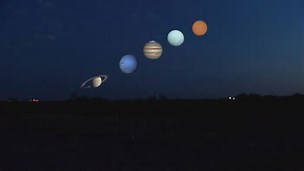
Lovers of the night sky are in for a rare treat this weekend. If clear skies prevail then five of the major planets should be visible to the naked eye.
This is an event that occurs approximately once each year when Saturn, Neptune, Jupiter, Uranus and Mercury will be in alignment. Depending on your location, this phenomenon can be observed from Earth on Saturday, June 17 and Sunday 18.
The new moon phase officially occurs on June 18 at 12:38 am 0438 GMT, according to In-The-Sky.org. The new moon is often referred to as the invisible phase because the moon’s illuminated side faces toward the sun and, as a result, is not visible to us here on Earth.
While for skywatchers, a new moon means there is no moon to “see,” many cultures view this lunar phase as a fresh start or new beginning because the new moon marks the start of a new lunar cycle.
As recommended by the experts, for the best viewing it is better to find a spot with no light pollution and a clear view of the horizon. The quality of viewing will also depend on whether you are located in the Northern or Southern Hemisphere.
Saturn, Jupiter and Mercury should be visible to the naked eye but the use of binoculars would make it a lot easier to look at Uranus and Neptune, as they are further away. One of the keys to recognising these celestial bodies is that Mercury will be the last one to appear, about an hour before sunrise.
Mercury will be closest to the Moon in the early hours of Saturday while Saturn will be visible higher in the sky until the Sun fully rises. This alignment of the five planets will not take place again until April 2024 and previously occurred on June 24, 2022.
The new moon is the first of four phases each month, as the moon takes 29.5 days to orbit Earth. During the new moon phase, the moon is in line with the sun, and the sun and Earth are on opposite sides of the moon. As a result, the moon appears to blend in with the dark night sky.
While you won’t be able to see the moon tonight, you will be able to see dimmer celestial objects like planets and stars that would otherwise be overshadowed by the bright moonlight. In fact, skywatchers will be treated to a planet parade this weekend as Saturn, Neptune, Jupiter, Uranus and Mercury line up a few hours before sunrise on June 18, just after the new moon.
According to experts, to differentiate between stars and planets, observers must look for objects whose brightness is not intermittent but rather uniform or constant. Seeing stars flickering in the sky is the result of their being a great distance away. That means any turbulence or atmospheric residue alters the amount of light that reaches us.
This is something that planets more distinguishable from stars, although they obviously do not have their own light.
To find out exactly where to look in the sky, the Stellarium website is a good source to consult. It displays the location and times at which each planet will be in the area and shows the alignment in which the five planets will be visible.
Another option is to download the Sky Tonight app, which allows you to point your mobile phone at the sky to see what is happening at that moment in real-time. Despite what is portrayed in science fiction films – usually linked to catastrophic events – the planets of our solar system never align in a perfectly straight line.
In a two-dimensional graph of the planets and their orbits, it looks like all the planets revolve around the same line. The reality though is that they do not all orbit in the same plane. Instead, they revolve in different orbits in three-dimensional space.
Just note that some of these planets are difficult to observe, even with a telescope. As EarthSky notes, Uranus can be tricky to spot even with dark skies. Mercury, meanwhile, rises low in the east just prior to sunrise, meaning not only will the sun’s glare make it difficult, but it can also be dangerous to point optics in the direction of the rising sun.
Sunday’s new moon is the last of the spring season, as summer officially begins in the Northern Hemisphere a few days later with the solstice (and longest day of the year) on June 21. By this time, skywatchers should be able to see a sliver of the moon as it peeks out from the sun’s glare.
In preparation for stargazing this summer, check out our guides for the best telescopes and best binoculars for spotting celestial objects in the night sky. And for astrophotographers, we’ve also shared our picks for the best cameras for astrophotography and best lenses for astrophotography.
As a result, the alignment is a partial vision of reality that, by coincidence in this case, is seen from our planet, as reported by larazon.es.
- A Tell / Euro News / Space report











